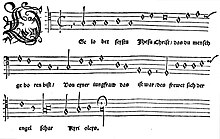
A Lutheran chorale is a musical setting of a Lutheran hymn, intended to be sung by a congregation in a German Protestant Church service. The typical four-part setting of a chorale, in which the sopranos sing the melody along with three lower voices, is known as a chorale harmonization.
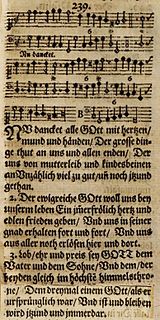
"Now thank we all our God" is a popular Christian hymn. Catherine Winkworth translated it from the German "Nun danket alle Gott", written c. 1636 by the Lutheran pastor Martin Rinkart. Its hymn tune, Zahn No. 5142, was published by Johann Crüger in the 1647 edition of his Praxis pietatis melica.

"Aus tiefer Not schrei ich zu dir", originally "Aus tieffer not schrey ich zu dir", later also "Aus tiefer Noth schrei' ich zu dir", is a Lutheran hymn of 1524, with words written by Martin Luther as a paraphrase of Psalm 130. It was first published in 1524 as one of eight songs in the first Lutheran hymnal, the Achtliederbuch, which contained four songs by Luther, three by Paul Speratus, and one by Justus Jonas, and also appeared the same year in the Erfurt Enchiridion. It is part of many hymnals, also in translations. The text inspired vocal and organ music from the Renaissance to contemporary, including composers such as Johann Sebastian Bach, who based a chorale cantata on it, Felix Mendelssohn and Max Reger.

"Nun komm, der Heiden Heiland" is a Lutheran chorale of 1524 with words written by Martin Luther, based on "Veni redemptor gentium" by Ambrose, and a melody, Zahn 1174, based on its plainchant. It was printed in the Erfurt Enchiridion of 1524.
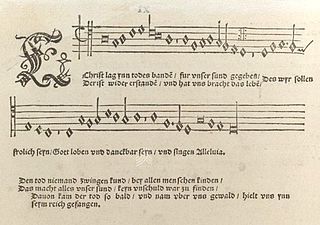
"Christ lag in Todesbanden" is an Easter hymn by Martin Luther. Its melody is by Luther and Johann Walter. Both the text and the melody were based on earlier examples. It was published in 1524 in the Erfurt Enchiridion and in Walter's choral hymnal Eyn geystlich Gesangk Buchleyn. Various composers, including Pachelbel, Bach and Telemann, have used the hymn in their compositions.
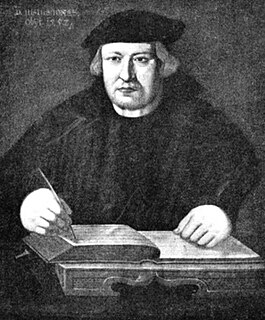
"Wo Gott der Herr nicht bei uns hält" is a Lutheran hymn by Justus Jonas, a paraphrase of Psalm 124 in eight stanzas. It was first published in 1524 in the Erfurt Enchiridion. The theme of the psalm is the need of help against raging enemies. It has been translated also as "Where the Lord God does not stand (stay) with us", "If God the Lord is not with us", "If God the Lord is not on our side", among others.

"Herr Christ, der einig Gotts Sohn" is a Lutheran hymn by Elisabeth Cruciger. Printed in 1524 in the Erfurt Enchiridion, together with 18 hymns by Martin Luther, it is one of the oldest Lutheran hymns. The text combines Lutheran teaching with medieval mysticism. It has been the basis of musical settings such as Bach's chorale cantata Herr Christ, der einge Gottessohn, BWV 96.
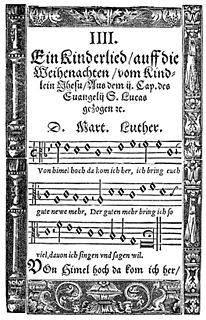
"Vom Himmel hoch, da komm ich her" is a hymn text relating to the Nativity of Jesus, written by Martin Luther in 1534. The hymn is most often sung to the melody, Zahn No. 346, which first appeared in a 1539 songbook and was probably also composed by Luther. This classic Christmas carol remains popular and has inspired many choral and organ works by other composers.

"Mit Fried und Freud ich fahr dahin" is a hymn by Martin Luther, a paraphrase in German of the Nunc dimittis, the canticle of Simeon. Luther wrote the text and melody, Zahn No. 3986, in 1524 and it was first published in the same year. Originally a song for Purification, it has been used for funerals. Luther included it in 1542 in Christliche Geseng ... zum Begrebniss.

"O Lamm Gottes, unschuldig" is an early Lutheran hymn, with text and melody attributed to Nikolaus Decius. Originally intended as a German version of the Latin Agnus Dei, it was instead used as a Passion hymn. In both contexts, the hymn has often been set to music, prominently as the cantus firmus in the opening chorus of Bach's St. Matthew Passion. It is included in most German hymnals, and has been translated by Catherine Winkworth, among others.
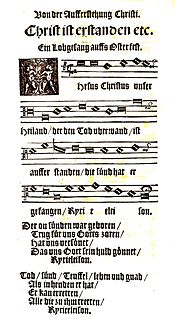
"Jesus Christus, unser Heiland, der den Tod überwand" is a hymn for Easter by Martin Luther. The text originated in 1524. Johannes Zahn listed three hymn tunes for it. Two of these, Zahn Nos. 1976 and 1977, were published in 1724. A third, Zahn No. 1978, is attributed to Luther and was first published in 1529. Variants of this melody originated up to the early 17th century.
"Jesus Christus, unser Heiland, der von uns den Gotteszorn wandt" is a Lutheran hymn in ten stanzas by Martin Luther for communion, first published in 1524 in the Erfurt Enchiridion. It is one of Luther's hymns which he wrote to strengthen his concepts of reformation. The models for the text and the melody of Luther's hymn existed in early 15th-century Bohemia. The text of the earlier hymn, "Jesus Christus nostra salus", goes back to the late 14th century. That hymn was embedded in a Hussite tradition.

"Christ unser Herr zum Jordan kam" is a Lutheran hymn about baptism by Martin Luther, written in 1541 and published in 1543. It has been set in many musical compositions, including cantatas and chorale preludes by Johann Sebastian Bach.

"Gott sei gelobet und gebenedeiet" is a Lutheran hymn of 1524 with words written by Martin Luther who used an older first stanza and melody. It is a song of thanks after communion. Luther's version in three stanzas was printed in the Erfurt Enchiridion of 1524 and in Johann Walter's choral hymnal Eyn geystlich Gesangk Buchleyn the same year. Today, the song appears in German hymnals, including both the Protestant Evangelisches Gesangbuch, and in a different version in the Catholic Gotteslob.

"Komm, Gott Schöpfer, Heiliger Geist" is a Lutheran hymn for Pentecost, with words written by Martin Luther based on the Latin "Veni Creator Spiritus". The hymn in seven stanzas was first published in 1524. Its hymn tunes are Zahn No. 294, derived from the chant of the Latin hymn, and Zahn No. 295, a later transformation of that melody. The number in the current Protestant hymnal Evangelisches Gesangbuch (EG) is 126.

Martin Luther was a great enthusiast for music, and this is why it forms a large part of Lutheran services; in particular, Luther admired the composers Josquin des Prez and Ludwig Senfl and wanted singing in the church to move away from the ars perfecta and towards singing as a Gemeinschaft (community). Lutheran hymns are sometimes known as chorales. Lutheran hymnody is well known for its doctrinal, didactic, and musical richness. Most Lutheran churches are active musically with choirs, handbell choirs, children's choirs, and occasionally change ringing groups that ring bells in a bell tower. Johann Sebastian Bach, a devout Lutheran, composed music for the Lutheran church: more than half of his over 1000 compositions are or contain Lutheran hymns.
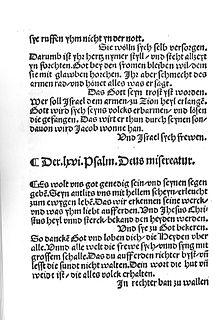
"Es woll uns Gott genädig sein" is a Lutheran hymn, with words written by Martin Luther based on the Psalm 67. The hymn in three stanzas of nine lines each was first published in Wittenberg in 1524. Its best known hymn tune, Zahn No. 7247, was published in Strasbourg in 1524. Heinrich Schütz and Johann Sebastian Bach wrote settings of the hymn. It was translated to English and has appeared in dozens of hymnals.
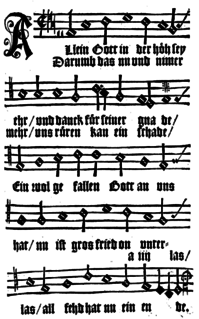
"Allein Gott in der Höh sei Ehr" is an early Lutheran hymn, with text and melody attributed to Nikolaus Decius. With the reformers intending church service in German, it was intended as a German version of the Gloria part of the Latin mass, used in almost every service. Decius wrote three stanzas, probably in 1523, while a fourth was added, probably by Joachim Slüter.

"Dies sind die heilgen zehn Gebot" is a hymn by the Protestant reformer Martin Luther based on the Ten Commandments. It appeared first in 1524 in the Erfurt Enchiridion.
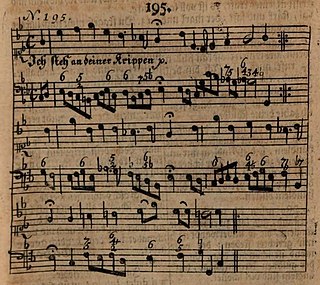
"Ich steh an deiner Krippen hier" is a German Christmas hymn, with lyrics by Paul Gerhardt which were first published in 1653. It was then sung with an older melody by Martin Luther, but a melody which was likely created by Johann Sebastian Bach for Schemellis Gesangbuch of 1736 is now part of current Protestant and Catholic hymnals.
